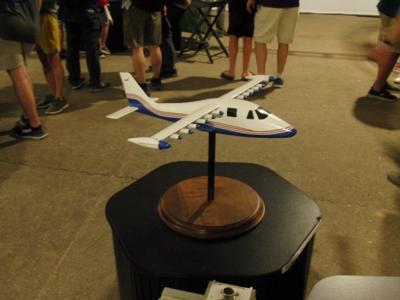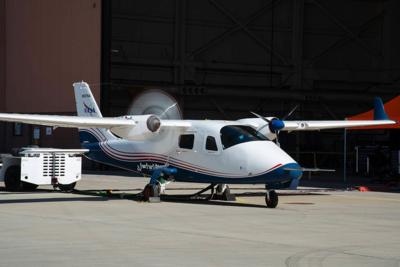A Lesson for Those Inclined to Learn
Among the most visited locales at EAA’s AirVenture 2023 is the NASA pavilion. Often a queue of event attendees forms outside the venue, each waiting patiently to enter therein—not only because the space is well air-conditioned, but because it houses a preview of aerospace’s future.

Near the pavilion’s center sits a small table atop which a model of a blue-and-white aircraft is displayed. Subject model depicts NASA’s X-57, an unusual high-wing monoplane bristling with underwing pods and fitted with sizable wingtip fixtures—an aircraft that could have been built but wasn’t.
Developed from an Italian-built airframe, the X-57 was to have been an all-electric, highly-efficient machine powered by a dozen underwing electric-motor/rotor assemblies and two larger such powerplants positioned at the distal termini of the aircraft’s wings. The X-57’s designers aspired to see their creation exhibit better flight-characteristics than the P2006T of which it derived.
Engineers posited outflow from the X-57’s outboard drive-rotors would serve to mitigate—perhaps even eliminate—induced drag resultant of wingtip vortices. It was believed, also, that the X-57’s optimized wing aspect-ratio and electric drive scheme would prove significantly more efficient than its progenitor’s more conventional wing and twin, one-hundred-horsepower, Rotax 912S3 horizontally-opposed, four-cylinder, geared, piston-engines.
Regrettably, NASA engineers soon discovered the X-57’s plethora of electric motors generated excessive Electromagnetic Interference (EMI). The issue proved correctable, but subsequent problems arose in short-order—not the least of which was a crippling lack of replacement components by which to keep the aircraft flying. Moreover, the novelty and complexity of the X-57’s electric powerplants gave rise to technical challenges beyond the project’s planned scope.

The discovery of safety-of-flight problems with the X-57’s propulsion system—problems not solvable within the program’s allocated budget—occasioned the June 2023 cancellation of the X-57 program in its entirety. The enterprise’s undertaking had been erroneously predicated upon the assumption that extant electric propulsion technology was sufficiently mature to facilitate safe flight.
Difficulties and setbacks notwithstanding, the X-57 program yielded advancements in lithium-ion battery design, which led in turn to the creation of cruise motor controllers—devices which utilize carbon transistors to control the distribution of electric energy.
Whether or not entities the likes of ZeroAvia and Universal Hydrogen succeed where NASA failed remains to be seen. What is certain, however, is that so long as politicians and environmental lobbyists persist in ascribing greater credence to optimism than to pragmatism, the pursuit of electric aero-propulsion schemes will continue, and the speed, endurance, and overall utility of emergent aircraft will diminish further, and further, and further still.
 ANN's Daily Aero-Linx (08.27.25)
ANN's Daily Aero-Linx (08.27.25) ANN's Daily Aero-Term (08.27.25): Class C Service
ANN's Daily Aero-Term (08.27.25): Class C Service ANN FAQ: Submit a News Story!
ANN FAQ: Submit a News Story! Airborne-NextGen 08.26.25: Iran UAV Knockoffs, X-37B Spaceplane, Army Training
Airborne-NextGen 08.26.25: Iran UAV Knockoffs, X-37B Spaceplane, Army Training Classic Klyde Morris (08.25.25)
Classic Klyde Morris (08.25.25)




